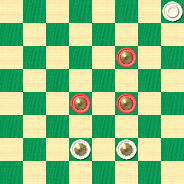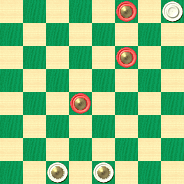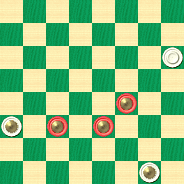The Checker Maven
Jump to navigationThree of a Kind

No, we don't know what they are either! When we think of "three of a kind" playing cards come to mind first, followed by a few other more ordinary images. Our photo is definitely "three of a kind" but the mystery of their identity will remain unsolved.
Today's Checker School entry is also three of a kind; or, at least, three variations on a common checker theme. In each setting, Black has three kings to White's two kings and a man, and it is up to Black to demonstrate a win. It's not an easy task, but the situations are very practical and knowing this theme will score you many an extra point in competitive play.
WHITE

BLACK
Black to Play and Win
B:W29,K7,K6:BK22,K15,K14.
WHITE

BLACK
Black to Play and Win
B:W29,K3,K2:BK30,K22,K15.
WHITE

BLACK
Black to Play and Win
B:W21,K12,K1:BK14,K11,K10.
In a sense, if you can solve one, you can solve them all; but it's easier said than done. As a small hint, you may wish to do these in reverse order, starting with the third diagram.
Give it a try, and note that as usual one thing is no mystery: clicking on Read More brings you the solutions, sample games, and many explanatory notes.![]()
Solutions
Solutions, games, commentary, and lettered notes are from Ben Boland's Famous Positions in the Game of Checkers. Numbered notes are by the Editor, and generally are derived from Ed Gilbert's KingsRow computer engine with 10-piece endgame database.
Johnson: 22-17, 6-2---A, 15-10, 7-3---B, 17-21, 3-8, 14-17, 8-11, 17-13---C, 11-16, 10-15, 2-6---D, 21-17, 6-1---E, 13-9, 1-5, 9-14, 5-1, 17-22, 1-5, 22-18, 16-12, 15-11, 29-25---F, 14-17, 25-21, 17-14, 5-1, 18-15, 1-5. Forms Diagram No. 3 at 2nd move.
Wardell: 15-10, 3-8, 30-25, 8-11---G, 25-21, 11-16, 10-15, 2-6, 21-17, 6-9, 22-18, 9-5---H, 17-14, 16-12---I, 15-11, 29-25, 14-17, 25-21, 17-14, 5-1, 18-15, 1-5, 15-19---J. Forms Diagram No. 3, at 3rd move.
Bowen: 10-15, 1-5---K, 15-19, 5-1, 14-9, 1-5, 9-6, 21-17---1, 19-15, 5-1---L, 6-9, 1-5---M, 9-13, 17-14, 11-7, 12-8, 7-2, 8-12, 13-9, (or 13-17), 14-10, 15-6, 5-14, 6-10. Black Wins.
Game: 11-15, 21-17, 9-13, 25-21, 8-11, 24-19, 15-24, 28-19, 11-15, 17-14, 15-24, 27-20, 10-17, 21-14, 6-10, 29-25, 10-17, 25-21, 2-6, 21-14, 6-10, 30-25, 10-17, 25-21, 1-6, 21-14, 6-10, 22-17, 13-22, 26-17, 10-15, 17-13, 7-10---P, 14-7, 3-10, 31-26, 10-14, 20-16, 12-19, 23-16, 14-17, 16-11, 15-19, 32-27, 17-21, 27-23, 19-24, 23-19, 24-27, 19-16, 27-31, 26-22, 31-26, 22-17, 26-22, 17-14, 22-18, 16-12, 18-9, 13-6, 5-9, 6-2, 9-14, 2-6, 14-18, 6-10, 18-23---Q, 10-15, 23-27, 15-19, 27-31, 19-23, 21-25, 12-8, 25-30, 8-3, 30-25, 11-7, 25-30---R, 7-2, 30-25, 2-7, 25-30, 7-11. Forms Wardell's position, colors reversed, after 1st move. Freeman vs. Barker Match, 1885, Page 217, British Draughts Player.
Game: 10-15, 21-17, 15-18, 23-14, 9-18, 22-15, 11-18, 24-19, 8-11---S, 17-13, 7-10, 26-23, 10-14, 31-26, 2-7, 28-24, 11-16, 24-20, 7-11, 25-22, 18-25, 29-22, 6-10---T, 22-18, 5-9, 13-6, 3-8, 18-9, 11-15, 20-11, 15-31, 6-2, 31-22, 2-7, 8-15, 7-14, 15-19, 23-16, 12-19, 14-10, 22-18---U, 9-6, 18-23---4, 6-2, 19-24, 2-7, 24-27, 30-26*, 23-30, 32-23, 30-26, 23-19, 1-5, 19-16, 5-9, 7-11, 26-22, 11-15, 22-17, 15-18, 9-13, 16-11, 17-21, 18-14, 13-17, 10-15, 17-22, 14-18, 21-25, 15-10, 22-26, 10-15, 25-30, 18-23, 26-31, 15-10, 30-25, 10-7, 25-30, 7-3, 30-25, 11-7, 25-30, 7-2, 30-25, 2-7, 25-30, 7-11. Forms Wardell's position, colors reversed, after 1st move. R. D. Banks vs. A. J. Mantell, Game No. 2998, Mt. Sterling (Ky.) Advocate, May 28, 1940.
A---6-1---N, 15-10, 7-2, 17-22, 1-5, 14-18, 5-9 (5-1, 18-15, 1-5, 22-18, 5-9, 10-7 Black Wins), 10-6, 9-5---O, 6-1, 2-7, 18-14, 7-11, 22-18, 11-16, 18-15, 29-25, 1-6, 5-1, 6-10, 16-12, 15-11, 1-5, 10-15, 5-1, , 15-18, 1-5, 14-17, 25-21, 17-14, 5-1. Black wins as in Bowen's.
B---7-11 loses at once by 14-18 (Lyman in his Problem Book gave 17-21 to a long ending, and so we find it in scores of books where Lyman's solution was copied), 11-8, 18-15, 8-3, 15-11, 29-25, 17-13, 25-21, 10-6. Black Wins.
C---Black threatens to exchange, if 11-8, then 10-6. Black Wins.
D---If 16-20, 15-19, 2-7, 13-17, 7-11, 17-22, 11-8, 21-25, 8-12, 25-30, 12-8 (20-16 then 22-26. Black Wins), 22-26, 8-3, 26-31, 3-7, 19-24. Black Wins. By first position.
E---If 6-2, then 13-9, 16-20, 15-19, 2-7, 9-14 (or 17-14), 7-11, 14-18, 11-8, 18-15, 8-12, 15-11, 29-25, now same as J. Wyllie's Glasgow Herald, No 48 at 2nd move, colors reversed; 17-21 (or 17-14), 25-22, 11-15, 12-8, 15-10 8-12 19-23 20-16, 23-26, 22-18, 26-23. Black Wins. Problem No. 129 Lyman's Problem Book.
E---If 16-12, then 15-11 as in Bowen's; and if 16-20, then 15-19, wins as in Note D.
F---5-1, 18-15, 1-5, 14-10, now if 5-1, then 11-16 wins; and if 29-25, then 10-14 as in Trunk.
G---8-3, 25-21, 3-8, 22-17, now same as Johnson at 7th move.
H---9-13, 17-14, 29-25, 15-19, 16-23, 18-27, 25-21, 27-23, 13-17, 14-9 17-22 (17-13, 9-6), 9-13, 21-17, 13-9, 17-13, 9-6, 22-17, 23-18. Black Wins.
I---16-20, 15-19, 29-25, 14-17, 25-21, 17-14, 5-1, 18-23, 1-6, 23-27 6-1, 27-32, 1-5, 19-24. Black Wins - First Position.
J---Wardell continued: 14-10, 21-17, 10-6, 5-1, 6-9, 1-5 (17-13, 9-5, 1-6, 5-1. Black Wins as in "First Without the Move"), 9-13, 17-14 same as Bowen's, at 14th move.
K---1-6, 14-10, 6-1, 11-16, 12-19, 15-24, 21-17, 24-19, 1-5, 19-15, 5-9, 15-18, 17-13, 10-14, 9-5, 18-15. Black Wins.
L---If 17-14, then 15-19, 5-1, 11-15. Black Wins; and if 17-13, then 6-1, 5-9, 15-10, 9-6, 10-14, 6-2, 14-9. Black Wins.
M---17-13, 9-5, 1-6, 5-1, 6-9, 15-10. Black Wins.
N---7-3, 15-11, now if 29-25, 11-7. Black Wins; if 6-2, then 14-10; 29-25, 17-13, 25-21, 10-6, Black Wins; and if 6-1, then 14-10, or 11-7 Black Wins. Again if 7-2, 14-10, now if 6-9, then 17-13, Black Wins; and if 6-1, 17-22, 1-5, 22-18, 5-9, 10-7, Black Wins. Also 29-25 loses at once by 15-19, White cannot go 25-21 or 6-10, and against the other moves, 17-21, 25-22, Black Wins.
Against 29-25 Johnson played 14-18, 7-10, 15-19, 6-9, 19-23, 25-21, 17-13, 10-6, 23-19, Black Wins. The shorter win has been shown many times. See the Draughts Review, Page 261, Nov. 1925, Vol. 1.
O---9-13, 6-1, 13-9 (forced or else 18-14), 22-17, 2-7, 17-14, 9-5, 18-15, 7-2, 15-11, 29-25, 11-15,2-7, 15-18,7-11, 14-17,25-21, 17-14. Black Wins.
P---15-19, 23-16, 12-19, 13-9, 7-10, 14-7, 5-14, 7-2, etc. Drawn. R. D. Yates.
Q---18-22 would have drawn. British Draughts Player.
R---Freeman continued; 25-22, 7-2, 22-17, 23-18, 31-27, 2-7, 17-21, 18-22, 27-24, 7-10, 24-20, 10-15, 20-24, 15-11, 24-19, 3-7, 19-24, 7-10, and Barker won.
S---This position is also reached from another 3 mover, thus: 10-14, 24-19, 14-18, 23-14, 9-18, 22-15, 11-18, 21-17, 8-11. Same.
T---This is where Black's trouble begins! It may draw, but it is an analytical problem---2. At this point, Denvir's Guide gives 6-9, 13-6, 1-10, 22-18, etc.. with a drawn result. However, instead of last move (22-18), play 27-24*, and White has a probable win---3. In place of 6-10, as given by Denvir, play 3-8*, and the White attack is finished. White has nothing better than 27-24 in reply; then 14-18*, 22-15 does the trick for an easy game for Black. A. J. Mantell.
U---Black's best try might be to run the ending into "Petterson's Drawbridge" (see elsewhere in book), instead of attempting to get through for another King---5. A. J. Mantell.
1---Not 1-5 because of 11-15 1-10 15-6 and Black wins with "the move."
2---Computer analysis yields a probable draw. See Note 4.
3---A deep computer search supports this conclusion; KingsRow chooses 27-24 here as well, showing enough of a White advantage to be a likely win.
4---This is the losing move according to KingsRow whereas 1-5 holds the draw.
5---Computer analysis however recommends 22-18, as played, and still shows a draw.
Johnson's Position may be found in the "New England Checker Play," as No. 278, July 1-879, Vol. 4. It was contributed by R. E. Bowen.
Wardell's Position may be found, colors reversed, as No. 175, "Lyman's Problem Book." But appeared first in "Turf," 1873.
Bowen's Position may be found in his 'Cross" Book, 1878, but was published before. It is known as one of his triplet positions, it is No. 157 in Lyman's Problem Book.
You can email the Webmaster with comments on this article.
